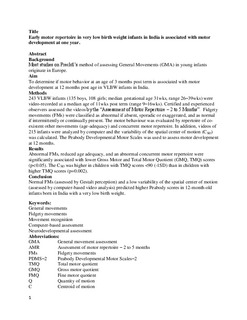| dc.contributor.author | Adde, Lars | |
| dc.contributor.author | Thomas, Niranjan | |
| dc.contributor.author | John b, Hima | |
| dc.contributor.author | Oommen, Samual p | |
| dc.contributor.author | Vaagen, Randi | |
| dc.contributor.author | Fjørtoft, Toril Synnøve Larsso | |
| dc.contributor.author | Jensenius, Alexander Refsum | |
| dc.contributor.author | Støen, Ragnhild | |
| dc.date.accessioned | 2016-08-24T12:12:36Z | |
| dc.date.accessioned | 2016-08-30T12:19:52Z | |
| dc.date.available | 2016-08-24T12:12:36Z | |
| dc.date.available | 2016-08-30T12:19:52Z | |
| dc.date.issued | 2016 | |
| dc.identifier.citation | European journal of paediatric neurology 2016 | nb_NO |
| dc.identifier.issn | 1090-3798 | |
| dc.identifier.uri | http://hdl.handle.net/11250/2402818 | |
| dc.description.abstract | Background:
Most studies on Prechtl's method of assessing General Movements (GMA) in young infants originate in Europe.
Aim:
To determine if motor behavior at an age of 3 months post term is associated with motor development at 12 months post age in VLBW infants in India.
Methods:
243 VLBW infants (135 boys, 108 girls; median gestational age 31wks, range 26–39wks) were video-recorded at a median age of 11wks post term (range 9–16wks). Certified and experienced observers assessed the videos by the “Assessment of Motor Repertoire – 2–5 Months”. Fidgety movements (FMs) were classified as abnormal if absent, sporadic or exaggerated, and as normal if intermittently or continually present. The motor behaviour was evaluated by repertoire of co-existent other movements (age-adequacy) and concurrent motor repertoire. In addition, videos of 215 infants were analyzed by computer and the variability of the spatial center of motion (CSD) was calculated. The Peabody Developmental Motor Scales was used to assess motor development at 12 months.
Results:
Abnormal FMs, reduced age adequacy, and an abnormal concurrent motor repertoire were significantly associated with lower Gross Motor and Total Motor Quotient (GMQ, TMQ) scores (p < 0.05). The CSD was higher in children with TMQ scores <90 (-1SD) than in children with higher TMQ scores (p = 0.002).
Conclusion:
Normal FMs (assessed by Gestalt perception) and a low variability of the spatial center of motion (assessed by computer-based video analysis) predicted higher Peabody scores in 12-month-old infants born in India with a very low birth weight. | nb_NO |
| dc.language.iso | eng | nb_NO |
| dc.publisher | Elsevier | nb_NO |
| dc.title | Early motor repertoire in very low birth weight infants in India is associated with motor development at one year | nb_NO |
| dc.type | Journal article | nb_NO |
| dc.type | Peer reviewed | nb_NO |
| dc.date.updated | 2016-08-24T12:12:36Z | |
| dc.source.journal | European journal of paediatric neurology | nb_NO |
| dc.identifier.doi | 10.1016/j.ejpn.2016.07.019 | |
| dc.identifier.cristin | 1373351 | |
| dc.description.localcode | © 2016 European Paediatric Neurology Society. Published by Elsevier Ltd. All rights reserved. Creative Commons Attribution Non-Commercial No Derivatives License. This is the authors' accepted and refereed manuscript to the article. Locked until 2017-07-30. | nb_NO |
